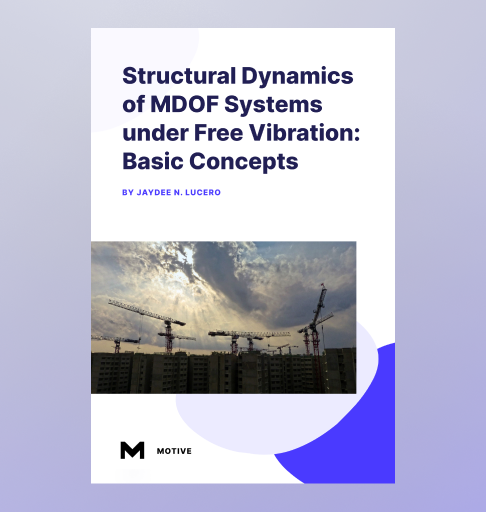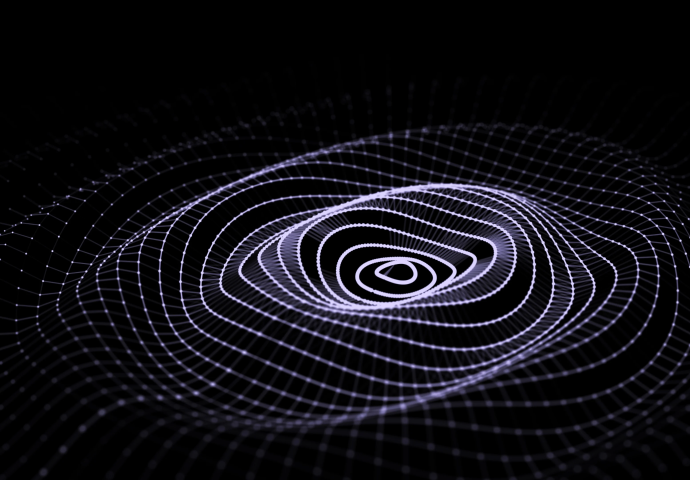One of the first concepts that is being taught in earthquake engineering classes is determination of dynamic properties of structures such as frequency and period. Under the action of earthquakes or external forces, the structure moves, and this movement is heavily influenced by its dynamic properties.
With the advent of industry softwares such as MIDAS Gen and open-source, research-based analysis softwares, calculation of these properties can now be done in seconds at best. However, many structural engineers, the author himself included, believe that the user should be able to manually calculate or at least understand the theoretical concepts these softwares use to check the accuracy of results and to better understand the structural model.
In this article, we will talk about the basic concepts in the structural dynamics of multiple degrees-of-freedom (MDOF) systems under free vibration. Softwares use concepts way more advanced than those presented here. Nevertheless, basic concepts are useful as the user is given a feel of how the structure (and the software he uses) works.
01 Definition of terms
But first, some definitions.
- A structure is in free vibration if it is set off with an initial input (e.g. an initial displacement) and then allowed to vibrate freely. This is in contrast with forced vibration, wherein the structure is given a force or displacement which persists over a certain period of time while the structure is vibrating.
- A structure is a shear-type structure if the slabs and beams are very rigid (has very high stiffness) with respect to the columns and walls. This is in contrast with bending-type structure in which the slabs and beams are flexible (has low stiffness) compared to columns and walls. The shear-type structure assumption is widely used in the analysis of structures, because it reduces the number of degrees of freedom of a two-dimensional frame from 6N to N, reducing the computational time. Here, N denotes the number of stories of the frame.
02 Theory
For the purposes of simplifying equations, consider a one-bay, two-story frame structure subject to free vibration as shown in Figure 1 below. Other structures can be analyzed in a similar manner.

Figure 1. A representative one-bay, two-story plane frame structure
We will assume the following.
- The structure is a shear-type structure. It follows that the columns can be considered to be fixed in between floors.
- The members are inextensible, meaning the members do not elongate or shorten under axial loads. This means that displacements are controlled by the movement of the slabs and are equal across all columns.
- The structure is displaced only along the x-direction. Together with its symmetry, we can consider the structure as a plane frame structure along the x-direction.
The equivalent lumped mass model and free-body diagram for each floor are also shown. We will designate all quantities related to the first-floor level with the subscript “1”, and the second-floor level with the subscript “2”.
Applying equilibrium equations for each floor and simplifying, we get the system

In matrix form, we can write the above system as
 This is the differential equation of motion for the MDOF systems in free vibration, which, in compact form, can be written as
This is the differential equation of motion for the MDOF systems in free vibration, which, in compact form, can be written as
[m]{u ̈ }+[c]{u ̇ }+[k]{u}={0}
which is very similar in form to that of SDOF systems. Here, [m], [c] and [k] are called mass, damping and stiffness matrices, respectively.
A special case worth considering is when we neglect damping in the structure, i.e. [c]=[0]. We have the equation

By making the substitution {u ̈ }=-ω_n^2 {u}, we have the eigenvalue problem

Because {𝑢} is nonzero, the only case this equation is true is when
![]() is equal to zero.
is equal to zero.
Solving this equation gives us 𝑁 values of frequencies 𝜔𝑛, which we call the modal frequencies of the structure. Usually, these values are arranged in increasing order, with the smallest one assigned to mode 1, or the fundamental mode of vibration. Now, we can substitute each modal frequency back to the eigenvalue problem and then get its corresponding value of{𝑢}. This {𝑢} is not exactly the actual displacement of the structure; rather, it shows the displacement of each floor relative to a certain value when the structure is subjected to a frequency 𝜔𝑛. In other words, it quantitatively shows how the structure looks like, given 𝜔𝑛. This is called the mode shape of the structure and is denoted by {𝜙𝑖 }, where 𝑖 is the 𝑖th mode. Usually, the topmost floor of the structure is assigned a unit displacement, in which case the mode shapes that we will obtain are called normal mode shapes. From this, we can get the mode shape matrix

Finally, some additional quantities. We have the modal mass matrix, given by
 and the modal stiffness matrix
and the modal stiffness matrix
 These two formulas allow us to convert a single system of differential equations of motion for MDOF systems into N independent differential equations of motion for SDOF systems, a process known as decoupling. Each of these differential equations can then be solved independently and then be combined later to get the response of the original structure.
These two formulas allow us to convert a single system of differential equations of motion for MDOF systems into N independent differential equations of motion for SDOF systems, a process known as decoupling. Each of these differential equations can then be solved independently and then be combined later to get the response of the original structure.
We also have the modal participation factor
 which can be written in element-wise form for the jth mode as
which can be written in element-wise form for the jth mode as
 Modal participation factor is a measure of the relative contribution of the jth mode of vibration to the overall response of the structure when subjected to ground motion.
Modal participation factor is a measure of the relative contribution of the jth mode of vibration to the overall response of the structure when subjected to ground motion.
03 Example
As an example, consider a three-story structure shown in Figures 2 to 5 below.
You can check more of these details in the download file.
04 Solution
4.1 | Mass and stiffness
4.2 | Modal frequencies and periods
4.3 | Mode shapes
4.4 | Modal matrices
4.5 | Modal participation factors
References
Estrada, H., & Lee, L. S. (2017b). Introduction to earthquake engineering. CRC Press.
Cimellaro, G. P., & Marasco, S. (2018). Introduction to dynamics of structures and earthquake engineering. Springer.
Association of Structural Engineers of the Philippines, Inc. (2019). National Structural Code of the Philippines 2015 (7th ed., Vol. 1). (Original work published 2015)
Saito, T. (2015). STERA 3D User Manual. https://rc.ace.tut.ac.jp/saito/Software/STERA_3D/STERA3D_user_manual.pdf

Jaydee N. Lucero is a Senior Structural Engineer I at Abinales Associates Engineers Consultants, where he brings over four years of experience in structural design and review. He's also a dedicated educator, having taught various mathematics and civil engineering subjects, and is an author of two books on calculator techniques. His achievements include a first-place finish in the November 2018 Civil Engineering Licensure Examination and a magna cum laude degree from the University of the Philippines Diliman.
※ Click on the keywords below 'Topics' to view related content.



![Design and Practical Examples of Baseplates and Anchor Rods [sample download]](https://2495902.fs1.hubspotusercontent-na1.net/hubfs/2495902/%EC%8D%B8%EB%84%A4%EC%9D%BC22.png)
![Understanding Drafting Standards [ Drawing download ]](https://2495902.fs1.hubspotusercontent-na1.net/hubfs/2495902/%EC%8D%B8%EB%84%A4%EC%9D%BC24.png)
![Key Changes in ACI 318-19: A New Standard for Structural Design [ PDF download]](https://2495902.fs1.hubspotusercontent-na1.net/hubfs/2495902/%EC%8D%B8%EB%84%A4%EC%9D%BC21-1.png)
![Design and Practical Examples of Lug design(ASME BTH-1) [sample download]](https://2495902.fs1.hubspotusercontent-na1.net/hubfs/2495902/%EC%8D%B8%EB%84%A4%EC%9D%BC20-1.png)





%20The%20Concept%20of%20Moving%20Load%20Based%20on%20Eurocode%20%E2%91%A0/The%20Concept%20of%20Moving%20Loads%20Based%20on%20Eurocode_345_240.png)